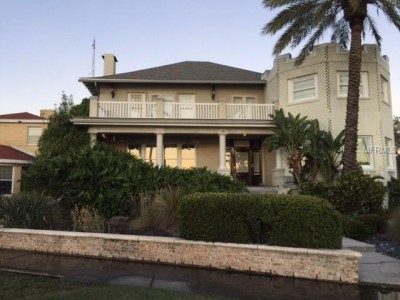 Philadelphia home; real estate prices in the city skyrocketed in 4Q 2015
Philadelphia home; real estate prices in the city skyrocketed in 4Q 2015
In an apparent reversal of the ongoing trend, luxury real estate prices in the United States increased in the fourth quarter of 2015 by 3.1 percent from the year-ago period, according to real estate brokerage Redfin.
The first three quarters of 2015 all saw the market slumping, but big gains in Philadelphia, Austin, TX and Sacramento, CA buoyed the market. Despite the good news, stock market volatility is leading big markets to decline and oil prices are shaking up some traditionally strong markets, so the increase may be an anomalous highpoint within a continuing downward trend.
"We are still waiting to see what impact oil prices might have on the Houston market and so are Houston homebuyers,” said Nela Richardson, chief economist at Redfin. “They are taking a wait and see approach and that may stall price appreciation there in the short term.
“In contrast to the rest of the country, we've also seen a big uptick in $1+ million homes in Houston, up 37 percent in the fourth quarter from a year ago. That has slowed price growth in that city.”
Redfin’s fourth quarter real estate report tracks all homes sold in at least the 95th percentile in more than 600 prices. Cities must have had 100 luxury sales to qualify as big winners or losers.
Going up?
For the purposes of Redfin, “luxury real estate” encompasses units priced in the top 5 percent of the market. Those in the bottom 95 percent of the market grew at a 5.4 percent rate, considerably faster than luxury real estate’s 3.1 percent for the fourth straight quarter.
The slowing economy led to declining prices in Houston, Miami, Chicago and Tampa, FL. Each are major luxury markets and therefore indicate the luxury buyer’s concern regarding the stock market and hesitance to purchase.
 Tampa, FL home for sale
While each experienced some of the biggest drops year-over-year, Tampa’s drop was especially large, at 14.7 percent. Only Baltimore, where prices fell by 17.9 percent year-over-year, experienced worse growth.
The Tampa luxury market is tied to the school year, so a fourth quarter drop off is typical. In Houston, low oil prices have provoked caution given the industry’s role in the city, but the diverse economy may cause a rebound.
Baltimore and Chicago are another story. A major increase in expensive homes for sale led to big decreases in price.
Tampa, FL home for sale
While each experienced some of the biggest drops year-over-year, Tampa’s drop was especially large, at 14.7 percent. Only Baltimore, where prices fell by 17.9 percent year-over-year, experienced worse growth.
The Tampa luxury market is tied to the school year, so a fourth quarter drop off is typical. In Houston, low oil prices have provoked caution given the industry’s role in the city, but the diverse economy may cause a rebound.
Baltimore and Chicago are another story. A major increase in expensive homes for sale led to big decreases in price.
 Chicago home listing via Redfin
On the other end of the market, Seattle, Portland, OR and southern Californian markets continue to grow. Sacramento experienced a 12.6 percent increase, attributable in part to buyers wanting to escape the high prices of San Francisco and Silicon Valley. The same thing likely attributed to Oakland’s growth the previous quarter.
“Low inventory and tech sector growth are fueling the real estate markets in these Pacific Northwest cities,” Ms. Richardson said. “There just aren’t enough homes for sale at every price point, which is frustrating buyers and pushing prices skyward.
“Meanwhile, an influx of high-income tech workers adds fuel to the fire,” she said. “Despite incredible price growth in Portland and Seattle over the last few years, homes still look relatively affordable compared to the Bay Area.”
Chicago home listing via Redfin
On the other end of the market, Seattle, Portland, OR and southern Californian markets continue to grow. Sacramento experienced a 12.6 percent increase, attributable in part to buyers wanting to escape the high prices of San Francisco and Silicon Valley. The same thing likely attributed to Oakland’s growth the previous quarter.
“Low inventory and tech sector growth are fueling the real estate markets in these Pacific Northwest cities,” Ms. Richardson said. “There just aren’t enough homes for sale at every price point, which is frustrating buyers and pushing prices skyward.
“Meanwhile, an influx of high-income tech workers adds fuel to the fire,” she said. “Despite incredible price growth in Portland and Seattle over the last few years, homes still look relatively affordable compared to the Bay Area.”
 Portland, OR home for sale
The biggest winners were Austin, a fast growing, trendy city, and Philadelphia. Philadelphia’s growth was less expected, with a Redfin agent speculating that the sale of several condos in a new Society Hill development likely played a part.
Indeed, Philadelphia entered Redfin’s list of the most “unequal” cities, or those in which the average price of a luxury sale is most out of proportion with the average sale in the bottom 95 percent of the market.
Coming down
Despite the uptick in the fourth quarter, other signs suggest that all but the most high-end markets might experience slowed growth in 2016.
While New York real estate boomed in 2015, the United States saw prices start to flatline in the second half of the year, possibly providing a preview for 2016.
While the demand for New York real estate will remain high for the foreseeable future, there are mixed signs as to what might happen with the country’s high-end market as a whole. Domestic and international economic factors will play a role in prices, while a growing millennial market could begin to impact what amenities are offered (see story).
Many of the trends and patterns in the fourth quarter reflect what Redfin found in the third quarter, from faster-growing non-luxury homes to worries over market volatility.
For the first time in three years, luxury home prices fell in the third quarter, according to Redfin’s previous report.
Although non-luxury home prices increased almost 4 percent, luxury homes fell 2.2 percent year-over-year. The drop reflects economic volatility overseas, in China but also Latin America, while also pointing to an increased supply (see story).
Slowing stock markets may lead some international buyers to invest in the relatively safe U.S. real estate, but the possibility of such consumers bolstering the market is not a sure bet.
“Real estate has been a bright spot in the U.S. economic recovery and investors are aware of that,” Ms. Richardson said. “Some foreign investors view U.S. real estate as a safe haven from global volatility.
“However, that can backfire at times,” she said. “Early this summer Redfin agents reported seeing deals fall through by Chinese buyers because of stock market volatility at home.
“Additionally, continued volatility in the U.S. stock market may cause some luxury buyers to delay or rethink purchases of second or vacation homes.”
Portland, OR home for sale
The biggest winners were Austin, a fast growing, trendy city, and Philadelphia. Philadelphia’s growth was less expected, with a Redfin agent speculating that the sale of several condos in a new Society Hill development likely played a part.
Indeed, Philadelphia entered Redfin’s list of the most “unequal” cities, or those in which the average price of a luxury sale is most out of proportion with the average sale in the bottom 95 percent of the market.
Coming down
Despite the uptick in the fourth quarter, other signs suggest that all but the most high-end markets might experience slowed growth in 2016.
While New York real estate boomed in 2015, the United States saw prices start to flatline in the second half of the year, possibly providing a preview for 2016.
While the demand for New York real estate will remain high for the foreseeable future, there are mixed signs as to what might happen with the country’s high-end market as a whole. Domestic and international economic factors will play a role in prices, while a growing millennial market could begin to impact what amenities are offered (see story).
Many of the trends and patterns in the fourth quarter reflect what Redfin found in the third quarter, from faster-growing non-luxury homes to worries over market volatility.
For the first time in three years, luxury home prices fell in the third quarter, according to Redfin’s previous report.
Although non-luxury home prices increased almost 4 percent, luxury homes fell 2.2 percent year-over-year. The drop reflects economic volatility overseas, in China but also Latin America, while also pointing to an increased supply (see story).
Slowing stock markets may lead some international buyers to invest in the relatively safe U.S. real estate, but the possibility of such consumers bolstering the market is not a sure bet.
“Real estate has been a bright spot in the U.S. economic recovery and investors are aware of that,” Ms. Richardson said. “Some foreign investors view U.S. real estate as a safe haven from global volatility.
“However, that can backfire at times,” she said. “Early this summer Redfin agents reported seeing deals fall through by Chinese buyers because of stock market volatility at home.
“Additionally, continued volatility in the U.S. stock market may cause some luxury buyers to delay or rethink purchases of second or vacation homes.”
